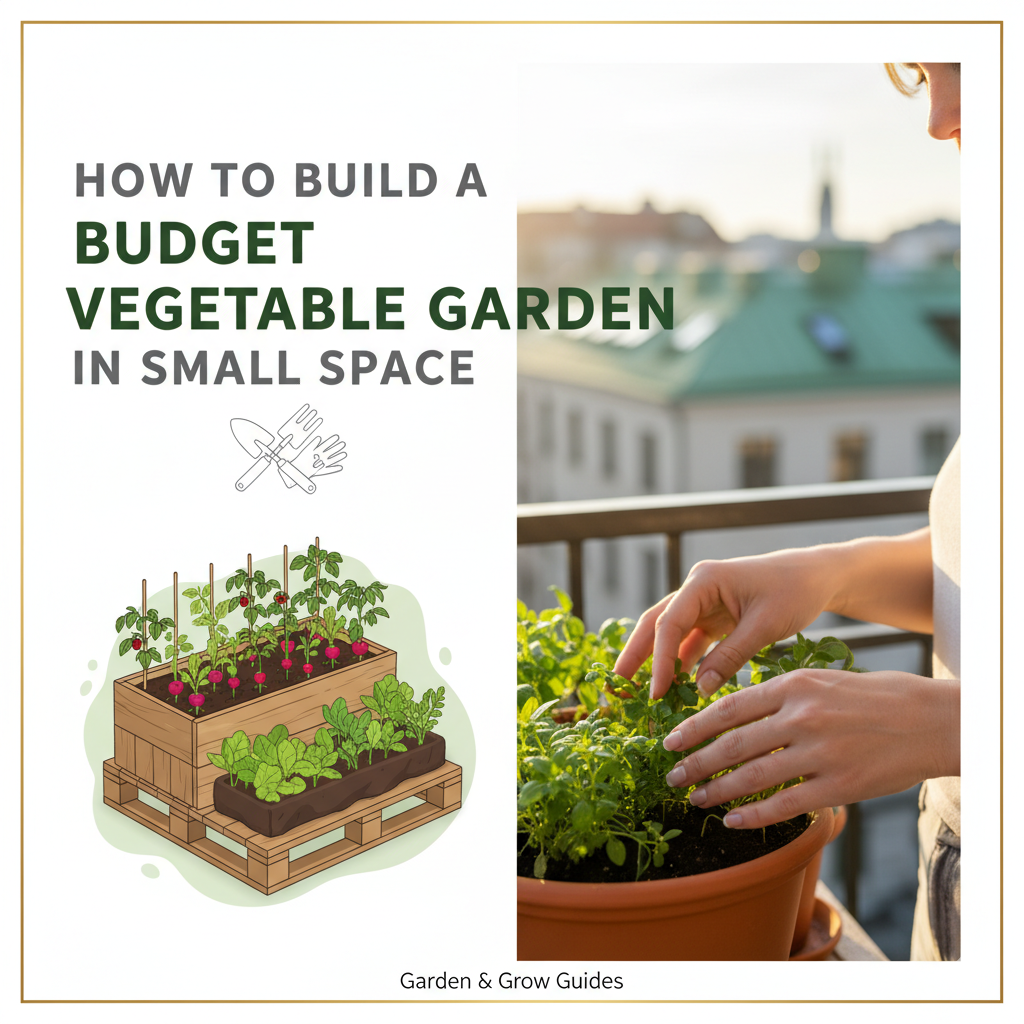How to Grow Plenty on a Shoestring: A Practical Guide
Starting a garden when you live in a small space shouldn’t cost a fortune. If you’re wondering how to build a budget vegetable garden in small space, this guide gives clear, step-by-step instructions that save money and maximize yield while fitting balconies, patios, or tiny yards.
Many beginners worry about tools, soil, and whether they have “enough room.” Learn how to build a budget vegetable garden in small space by using smart container choices, recycled materials, and compact plant varieties that produce well in tight quarters.
This article walks you through planning, cheap materials, space-saving layouts, and ongoing maintenance—everything you need to know about how to build a budget vegetable garden in small space so you can harvest fresh greens without breaking the bank.
Why a small, budget garden is worth it
Growing your own vegetables lowers food costs, reduces food miles, and gives better-tasting produce. Small spaces are ideal for herbs, salad greens, compact tomatoes, peppers, and fast-growing root crops. With the right planning you can get high yields per square foot and turn unused corners into productive growing areas.
Quick checklist (before you start)
-
Light assessment (hours of direct sun)
-
Available space (balcony, windowsill, patio, tiny yard)
-
Budget limit (set a realistic spending cap)
-
Water source accessibility
-
What you like to eat (prioritize high-value crops)
Step-by-step: planning and layout
-
Measure and map your area — Note dimensions and which spots get the most sun. Most vegetables need 5–6 hours of direct light; leafy greens tolerate less.
-
Choose containers and beds — Use planters, grow bags, recycled buckets, old drawers, or vertical towers. Think vertical to multiply area.
-
Pick compact varieties — Look for “bush,” “patio,” or “container” types of tomato, pepper, and cucumber. Radishes, lettuce, spinach, and herbs are perfect for small spaces.
-
Plan crop rotation in small cycles — Even tiny gardens benefit from alternating families (leafy — root — legume) to avoid soil depletion.
Low-cost materials and where to get them
-
Soil & compost: Mix inexpensive bulk topsoil with homemade compost and a handful of fertilizer. Save money by composting kitchen scraps.
-
Containers: Reuse plastic crates, buckets, laundry baskets (with drainage), wooden pallets (lined), or thrifted pots. Grow bags are cheap and lightweight.
-
Supports: Bamboo stakes, twine, or repurposed wire cages work as trellises for climbing plants.
-
Tools: A small trowel, watering can, and pruning shears are enough to start.
Tip: Local community groups, freecycling sites, and hardware clearance sections are goldmines for cheap materials.
Soil recipe for small spaces
A good container mix: 40% quality compost, 40% coconut coir or peat alternative (for water retention), 20% inexpensive topsoil or garden soil. Add slow-release organic fertilizer or a light liquid feed every few weeks during the season.
Watering and feeding on a budget
-
Group containers so you water efficiently.
-
Use a watering can or a low-flow hose; avoid overwatering.
-
Mulch with straw or shredded paper to reduce evaporation.
-
Use diluted kitchen tea (cooled vegetable/fruit tea) occasionally as a mild feed.
Space-saving layouts & techniques
-
Vertical gardening: Trellis cucumbers, peas, and pole beans upward.
-
Stacked planters: Use tiered shelves or hanging planters for herbs and strawberries.
-
Square-foot approach: Plant intensively—mix fast crops (radishes) with slower ones (carrots) to maximize yield.
-
Companion planting: Pair basil with tomatoes or lettuce under taller plants for shade.
Pest & disease control (cheap and safe)
-
Handpick pests early.
-
Use soap spray (mild dish soap + water) for aphids.
-
Encourage beneficials—ladybugs and lacewings—by planting flowers like marigolds and nasturtiums.
-
Rotate crops and remove diseased foliage to reduce problems.
Seasonal planning
Start seeds indoors in recycled containers to save on seedling costs. In warmer months, succession plant every 2–3 weeks for continuous harvest. In cooler months, focus on cold-tolerant greens and protected microclimates near walls.
One more practical tip
Use multi-purpose plants—herbs like basil and cilantro can be harvested frequently and also act as pest deterrents. Also, seed saving from the best performers reduces costs next season. (This is also helpful when you search for resources on how to build a budget vegetable garden in small space.)
FAQs
Q: What vegetables give the best yield in a small space?
A: Leafy greens (lettuce, spinach), bush beans, radishes, cherry tomatoes (compact varieties), peppers, and herbs give high yield per pot and quick returns.
Q: How often should I water container vegetables?
A: Containers dry out faster—check daily in hot weather. Water deeply when the top inch of soil is dry. Mulch helps reduce frequency.
Q: Can I compost in a tiny apartment?
A: Yes—use a small bokashi or vermicompost (worm bin) system for kitchen scraps; both are odor-controlled and suitable for small living spaces.
Q: Is building raised beds necessary?
A: Not at all. Raised beds help in yards but containers, grow bags, and vertical systems are sufficient for most small spaces.
Q: Where can I find cheap seeds or seedlings?
A: Local seed swaps, community gardens, thrift stores, and online budget seed sellers often have great deals.
Conclusion
You don’t need a backyard or a big budget to enjoy fresh produce at home. When you follow the practical steps here—choose the right spot, reuse materials, pick compact varieties, and maintain smart watering—you’ll see how simple and rewarding how to build a budget vegetable garden in small space can be. Start small, learn as you go, and expand sustainably; soon neighbors will be asking for tips on how to build a budget vegetable garden in small space, and you’ll be ready to share your success and methods for how to build a budget vegetable garden in small space with pride.


